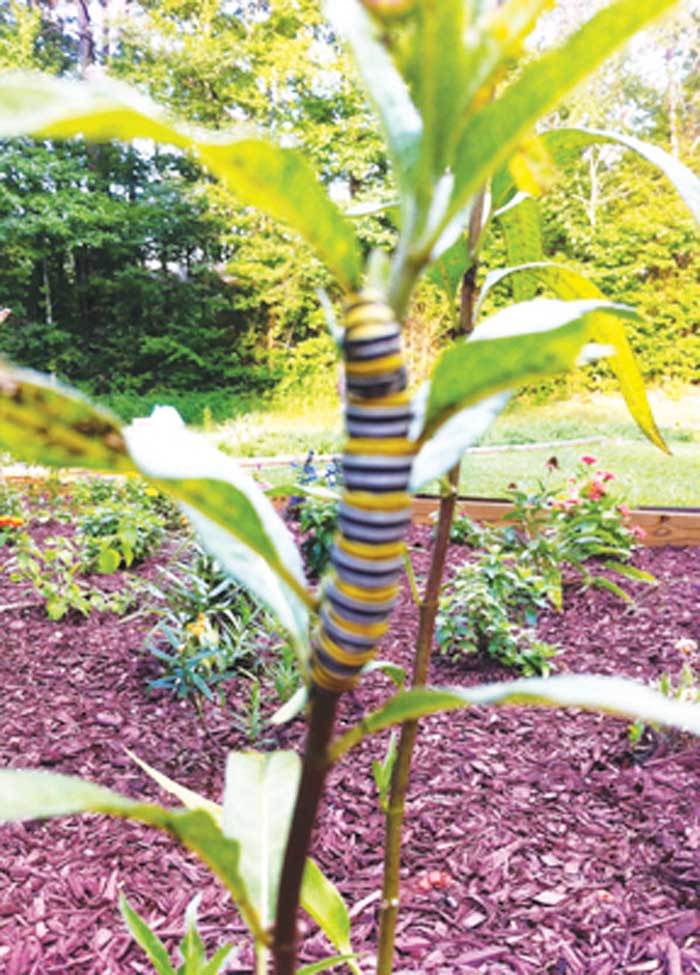Published 10:06 am Thursday, September 1, 2016

- A Monarch caterpillar on a Milkweed in the King's habitat.
By Chuck King
Special to the Enterprise
As a youngster growing up in Greensboro, I recall many spring and summer days chasing butterflies through the neighborhood with my brothers and friends. Imagine five or six kids with their butterfly nets raised high running down the street all trying to catch the same zebra or yellow swallowtail to add to a mounted collection. Granddad and dad even made us nice wooden boxes with glass tops as a display for the collection.
But my favorite recollection 50-plus years later was the great number of Monarch butterflies that would fly through during the fall on their migration back to their winter roosts in Mexico. Mom would follow the news of the migration, and she would always get excited about the upcoming sight as updates indicated the Monarchs would come through the area over the next few days. Sure enough, as on cue, one, two, three, followed by hundreds, probably thousands, would make their way through. What a glorious sight!
My wife and I moved to Davie County 18 years ago, and in the first five to six years of the new century, I recall seeing and photographing Monarchs as they migrated through the area in the fall. However, over the past 10 years there have been only a relatively few to be seen as their population has dwindled due to the development that has significantly reduced their over-wintering sites in Mexico.
I was excited as I read an article by Amy Dixon on July 1 in the Winston Salem Journal about a program in place by the Monarch Watch Organization that is dedicated to helping bring the Monarch population back up from their dangerously low levels. There has been much concern that the species could even go extinct in our lifetimes without the involvement of people in the path of their annual spring through fall migration from Mexico, to the northern U.S. and back to Mexico. During this time 4-5 generations are born and die as the last generation of the year then lives through the winter in Mexico and starts the new migration the following year.
The program promotes the establishment of Monarch waystations (gardens) along the broad migratory path throughout the U.S. These gardens range from small, just a few square feet, to giant, some 10,000 square feet plus.
The focus is to provide food and shelter for the Monarchs as they make their way through by planting milkweed on which the Monarch caterpillar feeds and other nectar rich flowers to give the newly emerged butterflies energy as they continue on their migration.
We started right away following up at the organization’s website, monarchwatch.org, to determine what we needed to create a suitable habitat for Monarchs on their migration. It turned out that many of the flowers and plants that attract and sustain these and many other butterflies are readily available at local home improvement garden centers and the many nurseries in the area.
We laid out an area of about 600 square feet to start with, built a raised bed, and proceeded to collect a variety of milkweed, small shrubs and bushy flowers for shelter and for feeding the growing caterpillars, along with other nectar flowers for the butterflies to feed on. We’ve been pleased with the variety of butterflies that have been visiting the garden already, and we have already seen one large Monarch caterpillar eating the milkweed and hope to see a butterfly emerge from its chrysalis, which we have not yet found and hope is well hidden somewhere in the garden or yard.
As a final note, we registered our garden through the MonarchWatch organization – number 14504, the first registered waystation in Davie County from what we see on the website, and plan to participate in the documentation of the numbers of Monarchs we see during the fall migration.
We have also begun preparing additional space to expand the garden next spring and summer.
This has been a really fun, educational project for us and we hope that it has some small, positive impact in helping the Monarch population return to sustainable levels.
We encourage others who would like to participate in this adventure to visit monarchwatch.org for more detailed information about Monarchs in general and what you can do to help these magnificent little creatures.




